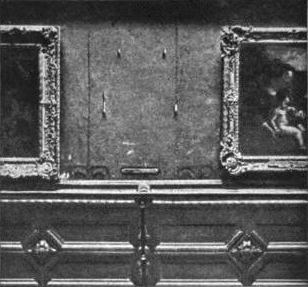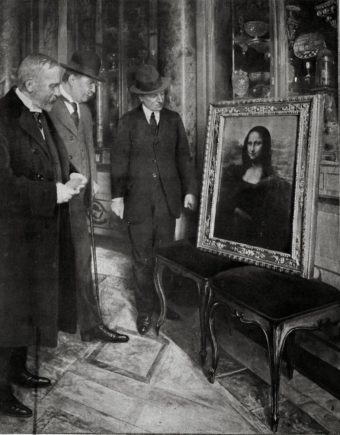The Mona Lisa Caper
 August 21, 1911. Louis Beroud, a painter, busily set up his easel in the Salon Carré, one of the Louvre’s more than 200 rooms, directly facing the spot where the Mona Lisa usually smiled out at her admirers. Beroud had painted copies of La Gioconda plenty of times before. But this time he planned to set up his own model next to the painting and paint the two together, with his model using the Mona Lisa’s protective glass case as a mirror. Beroud was looking back and forth between his equipment and the glass case, when suddenly he froze. There was an empty space where the Mona Lisa should have been.
August 21, 1911. Louis Beroud, a painter, busily set up his easel in the Salon Carré, one of the Louvre’s more than 200 rooms, directly facing the spot where the Mona Lisa usually smiled out at her admirers. Beroud had painted copies of La Gioconda plenty of times before. But this time he planned to set up his own model next to the painting and paint the two together, with his model using the Mona Lisa’s protective glass case as a mirror. Beroud was looking back and forth between his equipment and the glass case, when suddenly he froze. There was an empty space where the Mona Lisa should have been.
When he asked a guard where the painting was, he was told that it was in the photography room, where copies were made. Beroud waited three hours for the painting’s return, but eventually, his patience gave out. He asked the guard to go and see what was taking so long. When the guard returned after a few minutes, he had to admit to Beroud that the painting was nowhere to be found.
A DISPOSAL PROBLEM
What would an art thief do with the painting? At the time, it was worth about $5 million (4 million euros). But to whom would the thief sell it? Even if a buyer were willing to spend that much, the painting was too high profile to be passed along the art-theft network. It would be too easily traced, which meant that the perpetrators would be too easily caught.
Theories abounded in France; some thought it was an elaborate practical joke, while others thought it was a political ploy by the Germans to humiliate the French. Some accounts of the theft say that local Paris artists—Pablo Picasso, among them—were brought in for questioning. The city could not believe that such a treasure was gone forever.
OVERNIGHT SENSATION
In truth, the Louvre housed many treasures. But the theft transformed this particular one from valuable painting to icon. The Mona Lisa was now a cottage industry: Posters, postcards, mugs, pamphlets, nightclubs, silent movies, and magazine and newspaper articles featured her image. If T-shirts had been the fashion, her face would have graced every one of them. And behaviorists find it especially peculiar that after the theft, record crowds swarmed into the Louvre to gaze at the empty space where the Mona Lisa had once hung. Most of these visitors had never even seen the original. Why did people go to a museum to see a work of art that wasn’t there?
TURNING THE PLACE UPSIDE DOWN
It took a week for the museum to be searched completely. All that turned up was the painting’s empty gilt frame, found at the top of a staircase that the thief must have used as his escape route. The 38 × 21-inch (97 × 53-cm) wood panel that the Mona Lisa had been painted on was gone. Months passed, then years, and still no sign of her.
A LETTER FROM LEONARD
 November 29, 1913. A wealthy Italian art dealer, Alfredo Geri, received a letter from a Leonard Vincenzo. In the letter, Leonard offered to return the Mona Lisa to Italy, her home country—for a fee. Geri thought Leonard might be a crackpot, but he was intrigued enough to set up a meeting in Florence. There, in a hotel room, Leonard, a short, dark-haired, mustachioed Italian who’d been living and working in Paris at the time of the theft, reached under the bed and retrieved an object wrapped in red silk. He uncovered it and showed it to Geri and Giovanni Poggi, the director of Florence’s Uffizi Gallery. Poggi verified its authenticity: it was the Mona Lisa.
November 29, 1913. A wealthy Italian art dealer, Alfredo Geri, received a letter from a Leonard Vincenzo. In the letter, Leonard offered to return the Mona Lisa to Italy, her home country—for a fee. Geri thought Leonard might be a crackpot, but he was intrigued enough to set up a meeting in Florence. There, in a hotel room, Leonard, a short, dark-haired, mustachioed Italian who’d been living and working in Paris at the time of the theft, reached under the bed and retrieved an object wrapped in red silk. He uncovered it and showed it to Geri and Giovanni Poggi, the director of Florence’s Uffizi Gallery. Poggi verified its authenticity: it was the Mona Lisa.
ARREST THAT MAN!
While the painting hung temporarily in the Uffizi before being returned to Paris, Leonard was picked up by the police. His real name, he said, was Vincenzo Peruggia. He described the caper to the police. He’d entered the Louvre the morning of the theft dressed in a painter’s white smock and had gone straight for the girl of his dreams. No one else was in the Salon Carré that morning, so Peruggia simply removed the painting from the four wall hooks and concealed it, frame and all, under his smock. When he got to the staircase, he removed the painting from its frame, tucked the Mona Lisa back under his smock, and walked out. The whole thing took about 20 minutes.
THE PATRIOT?
In court, Peruggia said he’d stolen the painting for purely patriotic reasons: because she belonged in Italy—she had, after all, been painted by Leonardo da Vinci—and because he wanted to take vengeance on Napoléon for his various Italian conquests.
But during the trial, prosecutors brought up Peruggia’s criminal past. He had a prior record: an arrest in France for attempted robbery and illegal possession of firearms. What’s more, Peruggia’s diary was filled with the names of art dealers and collectors in the United States and Italy: names like J. P. Morgan, Andrew Carnegie…and Alfredo Geri, the art dealer who had helped bring him to justice.
ALL ROADS LEAD TO PARIS
Peruggia was sentenced to one year and 15 days; he served seven months. He eventually moved back to Paris and opened a hardware store.When he died in 1927, he still presented himself as one of Italy’s greatest patriots.
The Mona Lisa has been safely back at the Louvre since her recovery. Today, she smiles out—from her nearly impregnable, climate-controlled, bulletproof glass case—at more than five million admirers a year.
 This article is reprinted with permission from Uncle John’s Bathroom Reader Plunges Into History (Again). In it, Uncle John goes back in time to bring fans more compelling, confounding, and fascinating peeks into the world’s past. International in scope, you’ll read about historical events, people, and places worldwide. As always, the slant will be on revealing what they didn’t teach you in history class–history unexpunged!
This article is reprinted with permission from Uncle John’s Bathroom Reader Plunges Into History (Again). In it, Uncle John goes back in time to bring fans more compelling, confounding, and fascinating peeks into the world’s past. International in scope, you’ll read about historical events, people, and places worldwide. As always, the slant will be on revealing what they didn’t teach you in history class–history unexpunged!
Since 1987, the Bathroom Readers’ Institute has led the movement to stand up for those who sit down and read in the bathroom (and everywhere else for that matter). With more than 15 million books in print, the Uncle John’s Bathroom Reader series is the longest-running, most popular series of its kind in the world.
If you like Today I Found Out, I guarantee you’ll love the Bathroom Reader Institute’s books, so check them out!
| Share the Knowledge! |
|




